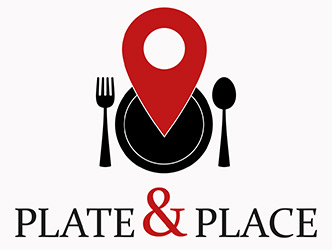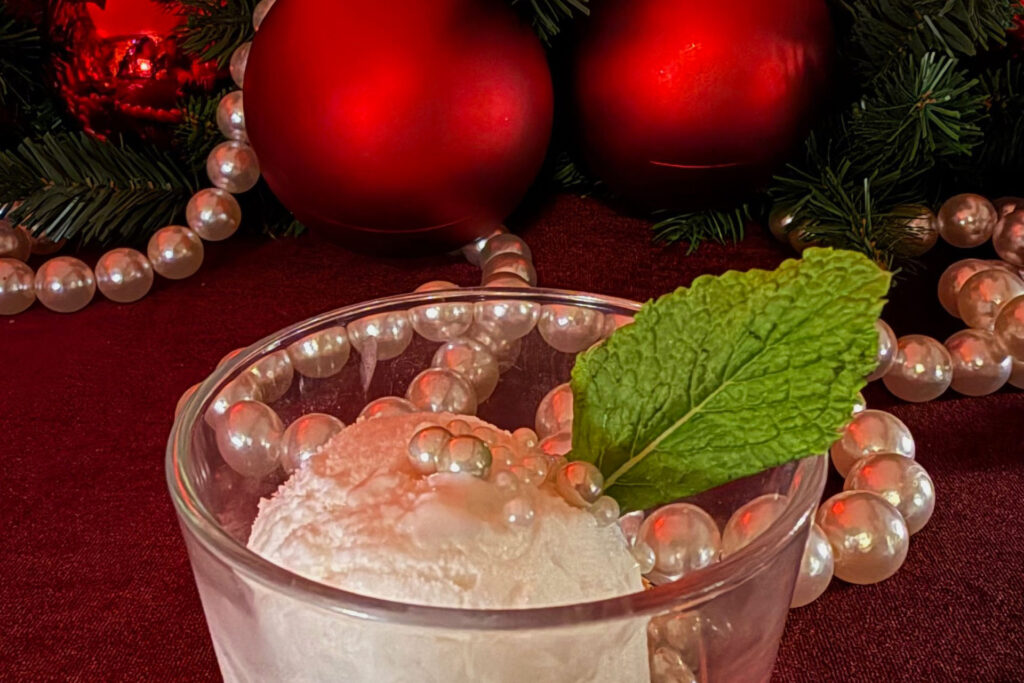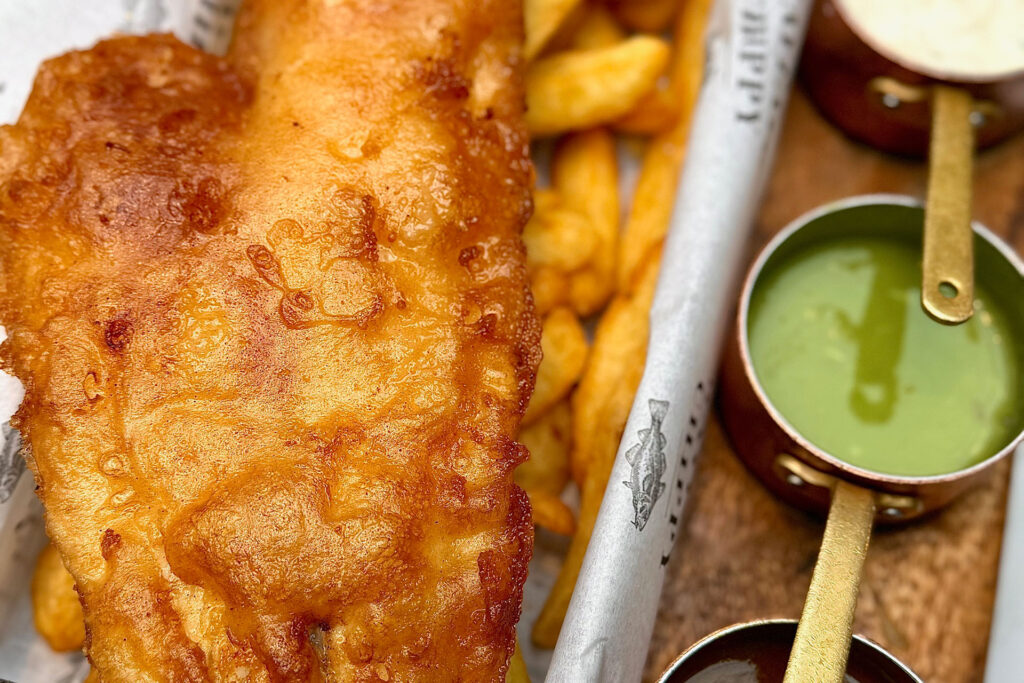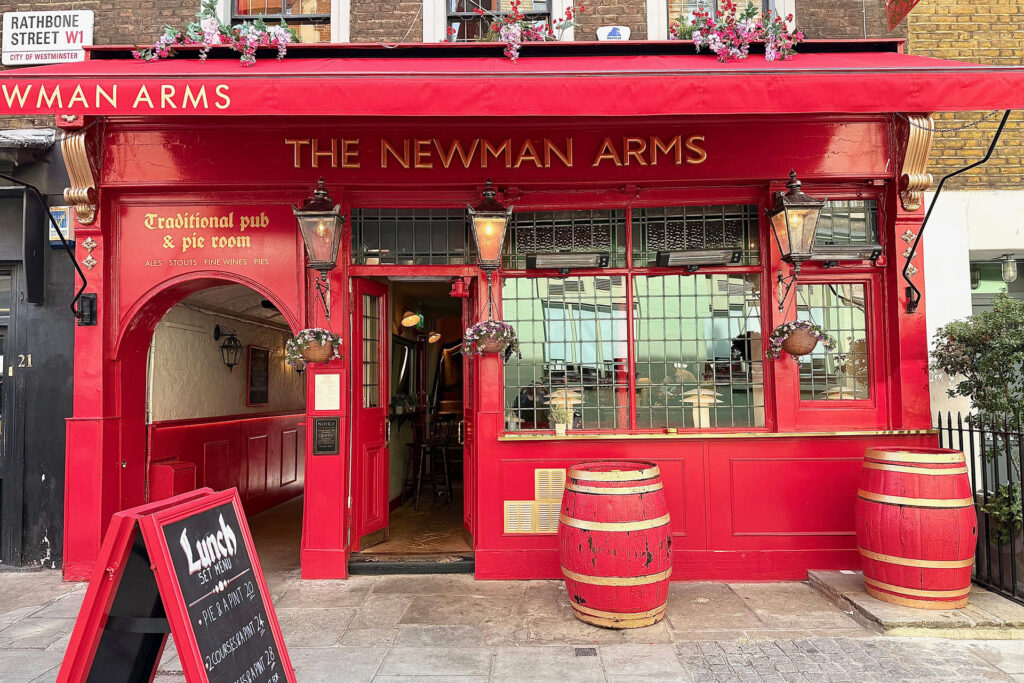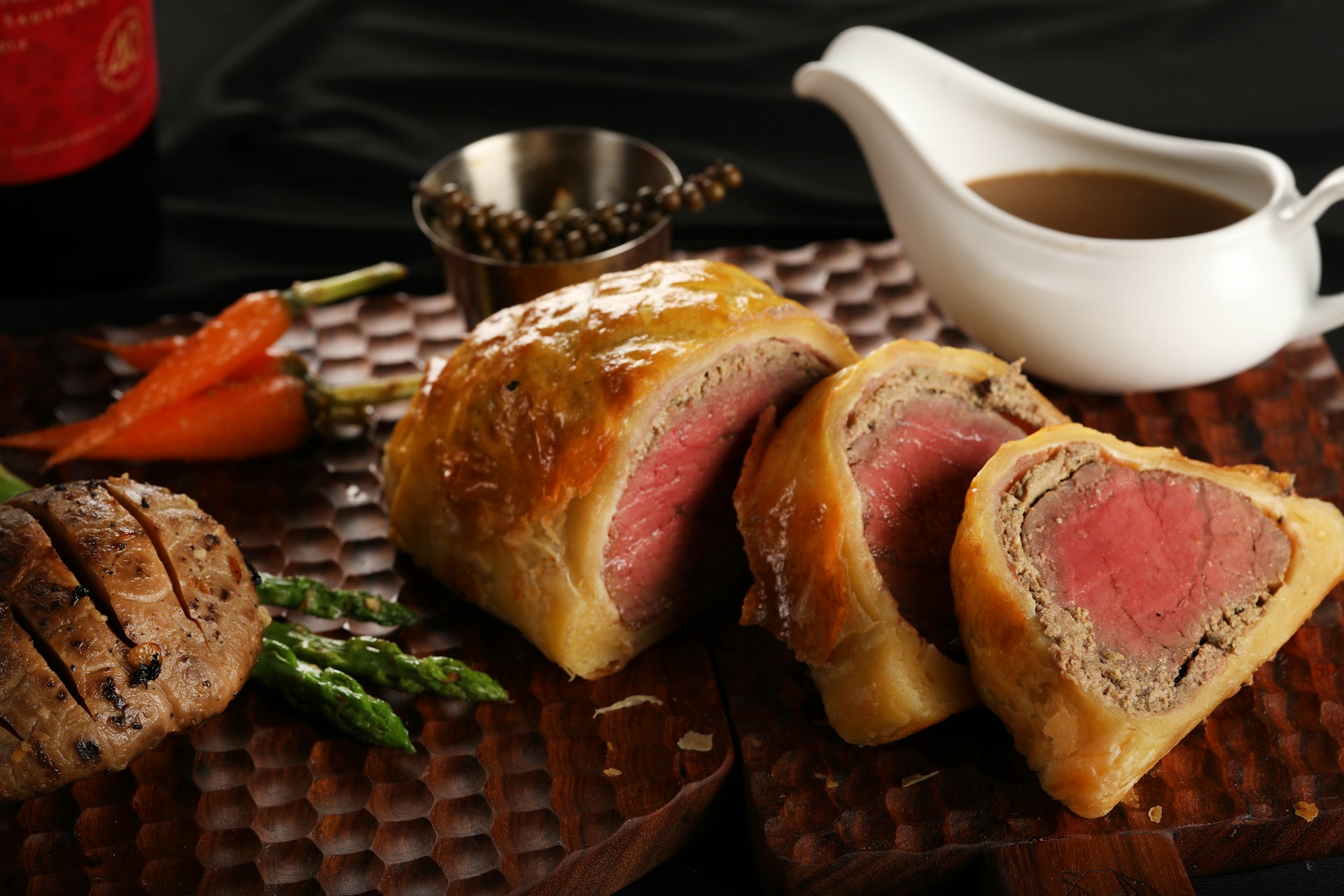
When the time comes to plan a trip to London, only two things matter in our opinion: having the perfect base to ensure you get the most out of the city, and secondly, an itinerary of all the must-try foods.
It aways has and always will be about the food for us, and London is home to some of the world’s best dishes. If you’re looking to find out more about the UK’s food scene and indulge in some classic, regional dishes you will discover them all throughout this great city.
Whether you want to sample a classic Sunday roast lunch, a decadent sticky toffee pudding, or simply discover why Londoners still flock in their droves to their local pie shop – we have the definitive guide to the must-try foods while visiting London.
As the Brits would say, “Dig in!”.
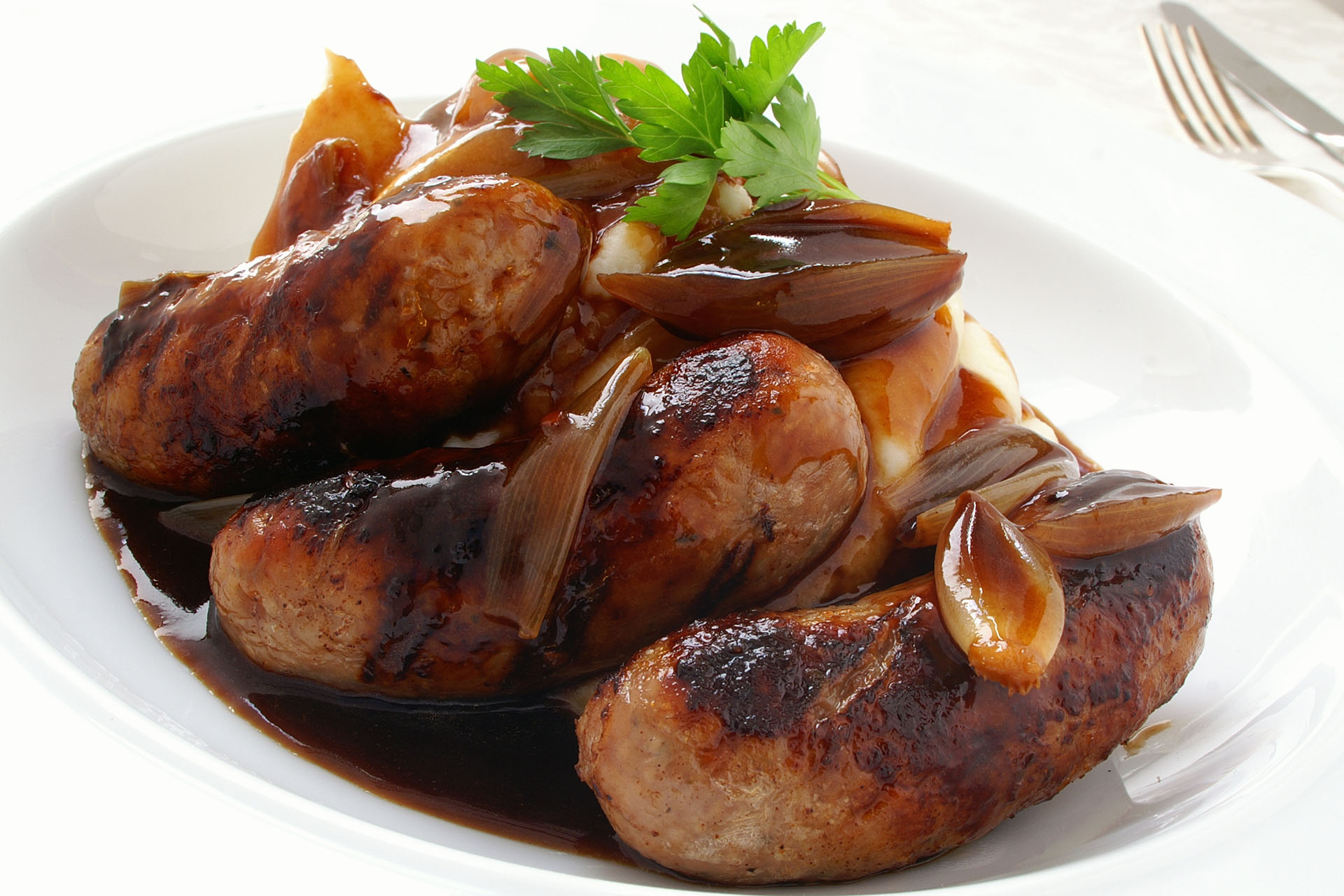
Sausage & Mash
This beloved dish, also more popularly known as ‘Bangers and Mash’ is a staple of British cuisine and one of the most popular go-to comfort foods. You will see this dish on (almost) every pub menu up and down the country, each venue adding their own twist to the dish whether serving with a classic onion gravy, or a fancier, red wine jus.
You may wonder why the term ‘banger’ was applied to the humble sausage? Well, this unusual moniker came about during World War I, and over the course of the Second World War. During war time, food was scarce, and sausages were made with whatever was available at the time, largely filled with cereal and water to bulk them out. As you can imagine, when the sausages were cooked the water would react with the oil and would spit and ‘bang’ which is where the term originated from. Luckily, we don’t have such an issue now with sausages containing high quality meat.
If you have yet to try the classic Sausage and Mash, your first stop should be Mother Mash, located centrally in Covent Garden. They produce the ultimate, feel-good dishes with quality mash and organic sausage. You can tailor this meal in any way you wish, for example, you can swap the classic mashed potato for sweet potato or even horseradish mash. You also get to choose from a variety of sausages including the classic Cumberland (our preferred choice), Pork and Chilli, as well as Vegetable and Herb.
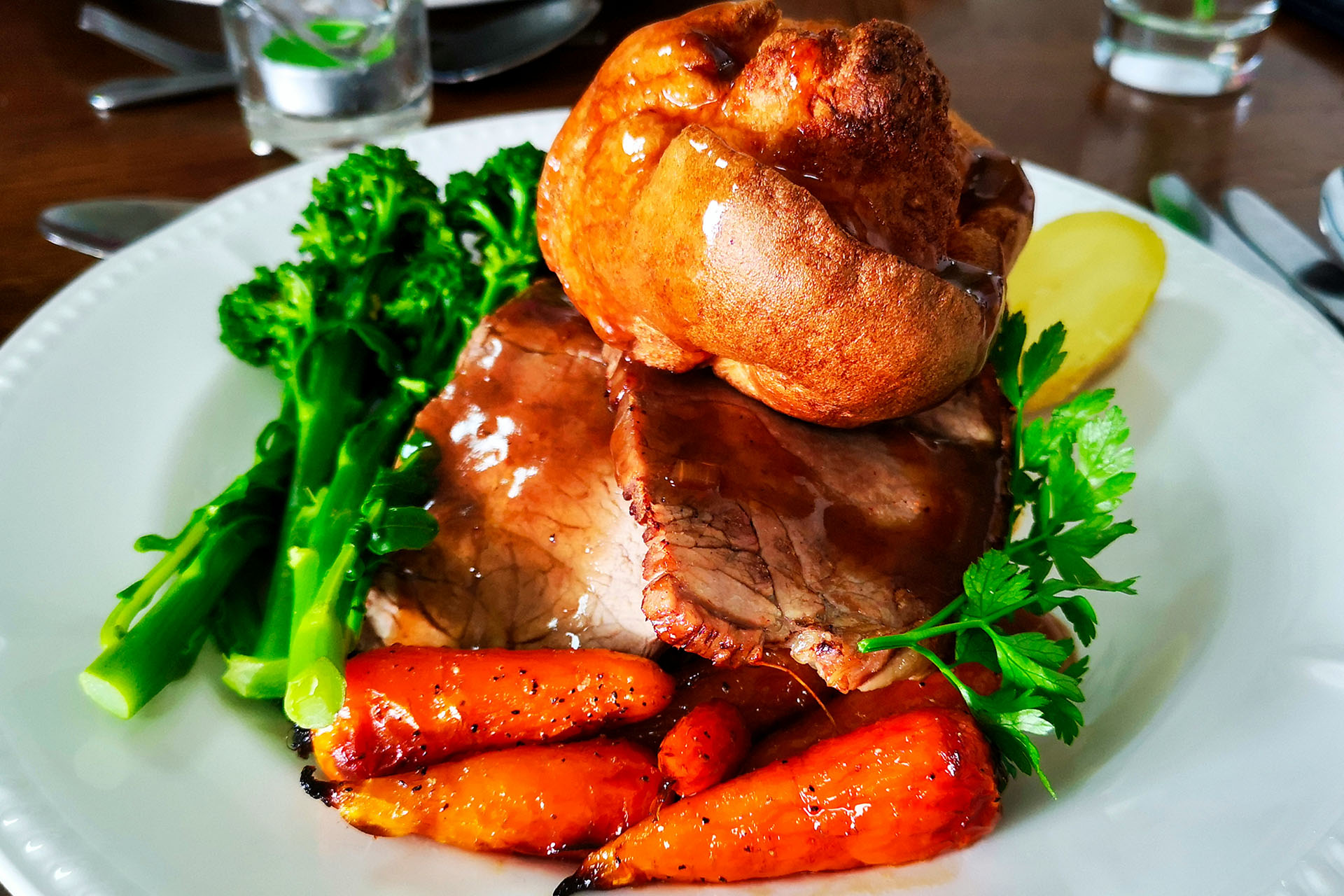
Sunday Roast
If happiness could be put onto a plate, many would conclude that the traditional Roast Dinner is a ‘hug’ in food form. This dish is a true national treasure and a stalwart of the Sunday afternoon ritual.
The classic roast dinner consists of a roasted meat (usually chicken, beef or lamb) surrounded by a myriad of vegetables, including crispy roast potatoes as well as Yorkshire Pudding (savour puddings made of flour, eggs and milk) and lashings of homemade gravy. There are additions and subtractions of course, but if you were to ask for a traditional roast dinner at any restaurant or pub, you would receive something resembling our description. Your plate would likely be piled high – there shouldn’t be any scrimping when it comes to a good roast dinner.
The Sunday roast is one of the most long-standing traditions and its origins go back to the 15th century, during the reign of Kings Henry VIII. Meat was always eaten in large quantities at royal banquets and amongst the wealthy. However, eating meat wasn’t just for royalty, villagers would also eat a communal meal after Church services and would gather to enjoy a feast of their own – although likely not as extravagant as the reigning monarch of the times. This ancient tradition has passed on through the ages, right through to the present day.
If you’re looking for a classic roast lunch, we are positively salivating at the thought of the generous and delicious offerings at The Marksman in Hackney. This is not your average pub roast, as they prepare only the finest quality meats, with the vegetables cooked to absolute perfection. Our choice would be the Roast Hereford Rump Beef, with Yorkshire pudding and horseradish cream.
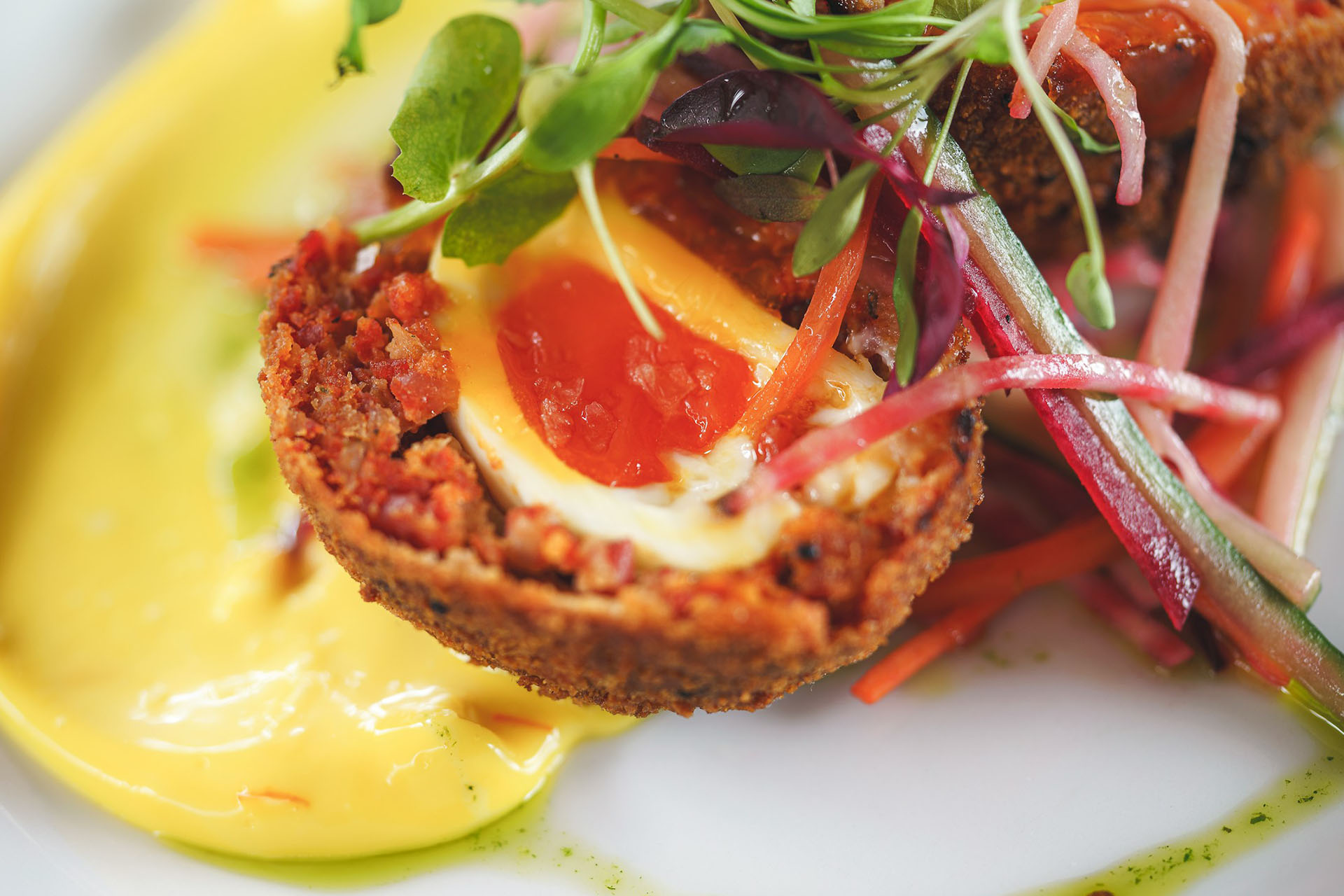
Scotch Egg
This delicious, protein-rich snack is often seen peeking out of lunch boxes and summer picnics throughout the UK. It’s the ultimate item for easy, food-on-the-go. This popular snack consists of a hard-boiled egg encased in sausage meat and then deep fried in breadcrumbs. You can easily purchase them from any supermarket, but when made fresh there’s nothing quite so scrummy, especially if you have a fudgy yolk centre.
The Scotch Egg was said to have been created by the legendary Fortnum & Mason department store in 1738, however, this is widely debated as there are claims it came from Whitby in Yorkshire during the 19th century where it was covered in fish paste rather than the traditional sausage meat that we know now. Another theory is that it is said to have originated from a Mughlai dish translated as “Narcissus meatballs”.
You can find Scotch eggs all over the country, particularly in pubs and restaurants where they are more often freshly prepared. If you’re looking for the real thing, there is a very special pub where we can vouch for the quality: The Harwood Arms in Fulham, is the first pub to be awarded a Michelin star so it’s no surprise their scotch egg (venison in this case) is one of the best in London. It must be tried to be believed!
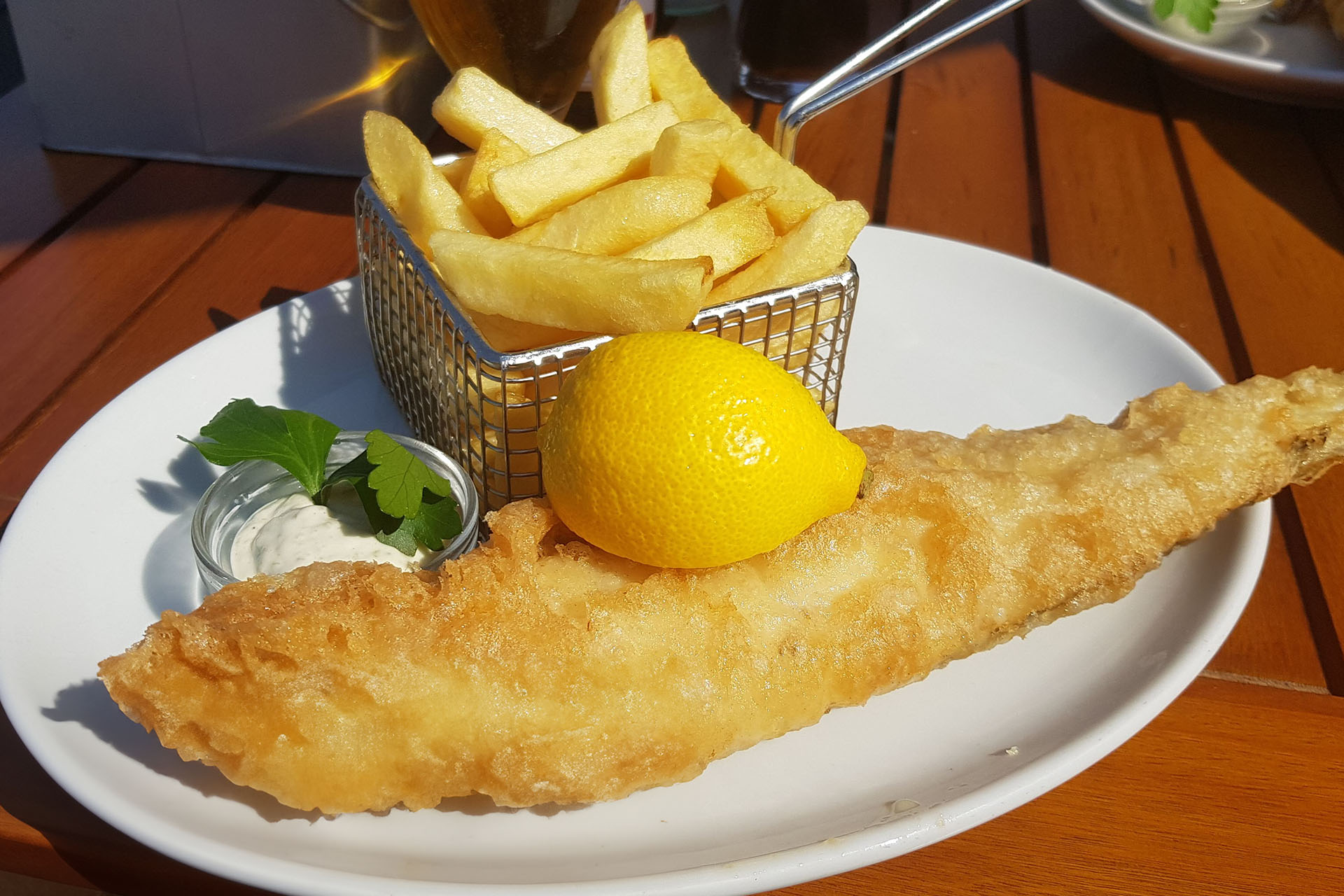
Fish & Chips
If there’s one dish that should be on your to-do list when visiting London it’s a decidedly a no-brainer on our end: a classic Fish and Chip supper. This beloved dish consists of deep-fried fish (usually cod or haddock) with a mountain of crispy chips and, if you’re a purist, a side of mushy peas, all sprinkled with salt and a good dousing of malt vinegar. It should be abundant with plenty of leftover chips for sandwiches later – chips on buttered bread is a must-try – just trust us.
This humble dish first came about during the 19th century, with the first known fish and chip shop opening in Bow, East London by Jewish immigrant, Joseph Malin. He truly was a man ahead of his time, with the dish becoming one of the most popular of the era and a staple of the working-class diet.
Fast forward to today, fish and chips can still be a humble affair and is often served in paper wrapping (if you’re ordering the food to take away), however, it has equally become a more glamorous affair with fish and chips getting a high-end make-over, particularly with the latest restaurant from Tom Kerridge opening in the illustrious surrounds of Harrods Food Hall.
With so much choice in London, you may wonder where is the best place to enjoy this classic supper? Well, if you want to go all out and enjoy something a little bit special it would have to be our personal favourite, The Mayfair Chippy. This lovely restaurant focuses on quality above all, and we think this is one of the best introductions to the classic fish and chips.
You can find more recommendations for the Best Fish & Chip Restaurants In London here.
Best of all, your meal comes with three perfectly matched condiments: curry sauce, tartare sauce and mushy peas – what could be better?
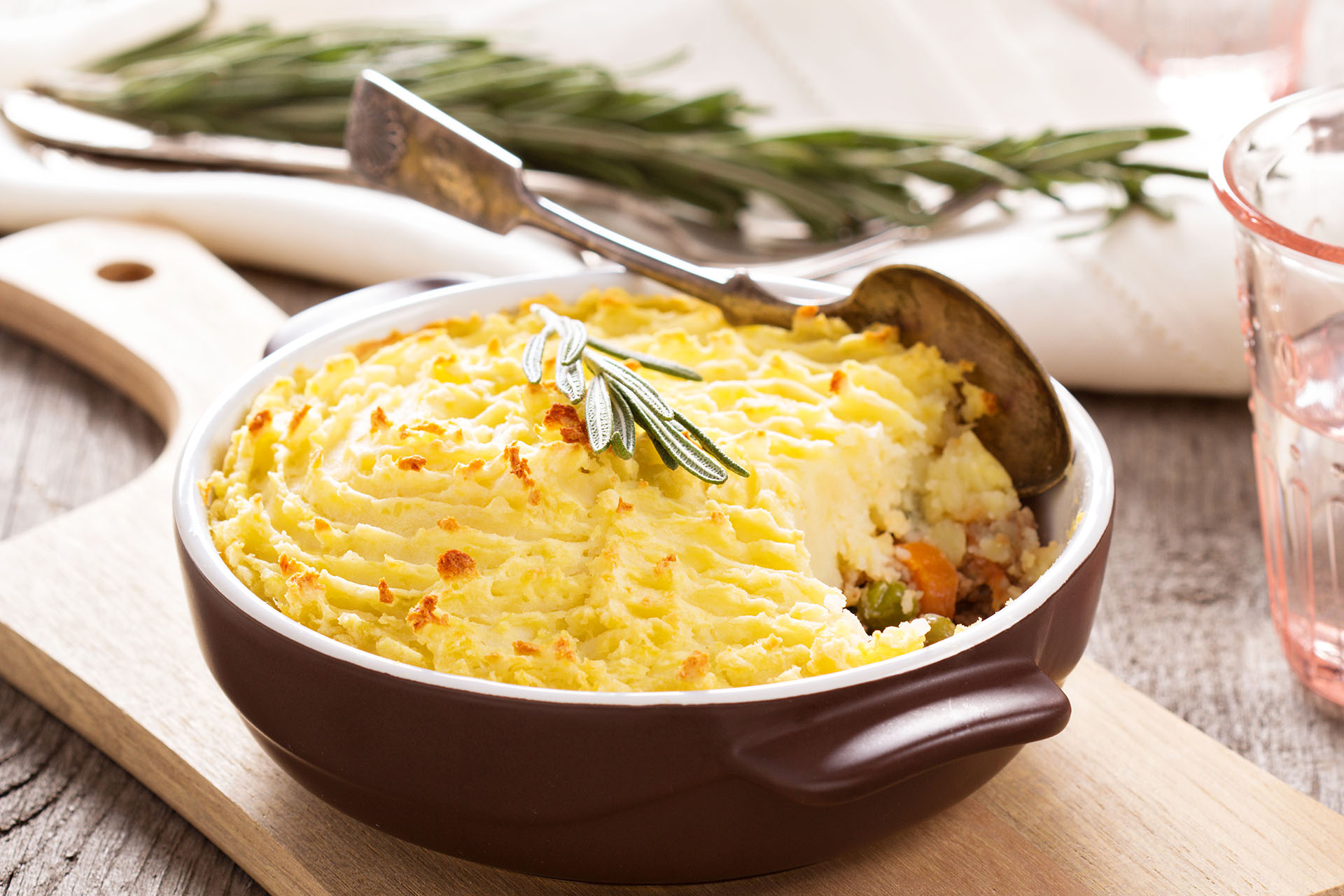
Shepherd’s Pie
For cold winter evenings or for whenever extra comfort is needed, there’s nothing quite like the prospect of a homemade Shepherd’s Pie. It’s the simplicity which makes this such a familiar, cosy favourite: cooked lamb mince topped with fluffy mashed potato. The lamb mince renders a deep, flavourful sauce made with a mixture of chopped vegetables (onions and carrots) along with beef stock and Worcestershire sauce. The mashed potato is usually combined with warmed milk and butter and a final sprinkle of mature cheese giving it extra flavour and savouriness. The dish is then grilled to give the mash potato a crispy topping.
Shepherd’s Pie has a long history and was first recorded in a cookbook back in 1877. The dish is of Irish origin; however, some have argued it originated in Scotland. It came to prominence during the 18th and 19th centuries when the poorest in society who had to make food stretch as far as possible repurposed any leftovers. At the time, pastry was used rather than potato but over time the dish evolved into the fluffy topped pie that it is today.
If you’re looking for a restaurant quality introduction to this dish but with a fancier twist you can’t go wrong with The Ivy’s sublime take on the Shepherd’s Pie. It certainly isn’t ‘humble’ here but is executed to perfection – rich, pate-soft meat with the smoothest, buttery mash. It’s aways a go-to order when dining at this iconic restaurant.

Pie & Mash with Liquor
You can’t get a dish anymore ‘London’ than the holy trinity of the east end: pie, mash and liquor. This iconic dish is epitome of old London having first been introduced around the 19th century. This humble dish consists of mince beef encased in pastry alongside mashed potato and parsley sauce otherwise known as ‘liquor’. Traditionally, the liquor was made using eel stock but is more commonly now just a simple parsley sauce as many customers would find the addition of eel stock off-putting.
A traditional pie, mash and liquor was a working-class meal and first came to prominence around the London dockyards in the 19th century. It would often be accompanied by jellied eels which would have been seen as an east London delicacy. The dish was incredibly popular as it was easily portable for workers and was generally made with the cheapest cuts of meat, often mutton.
If you’re looking for the real deal, you need to check out the Goddard’s of Greenwich – a true local legend which was founded in 1890. The pies are all homemade and to a traditional family recipe. We particularly like this shop as the menu is extensive which gives you the choice of a traditional minced beef pie, as well as alternative fillings such as chicken and ham, and cheese and onion. There’s also seating inside, which is a bonus.
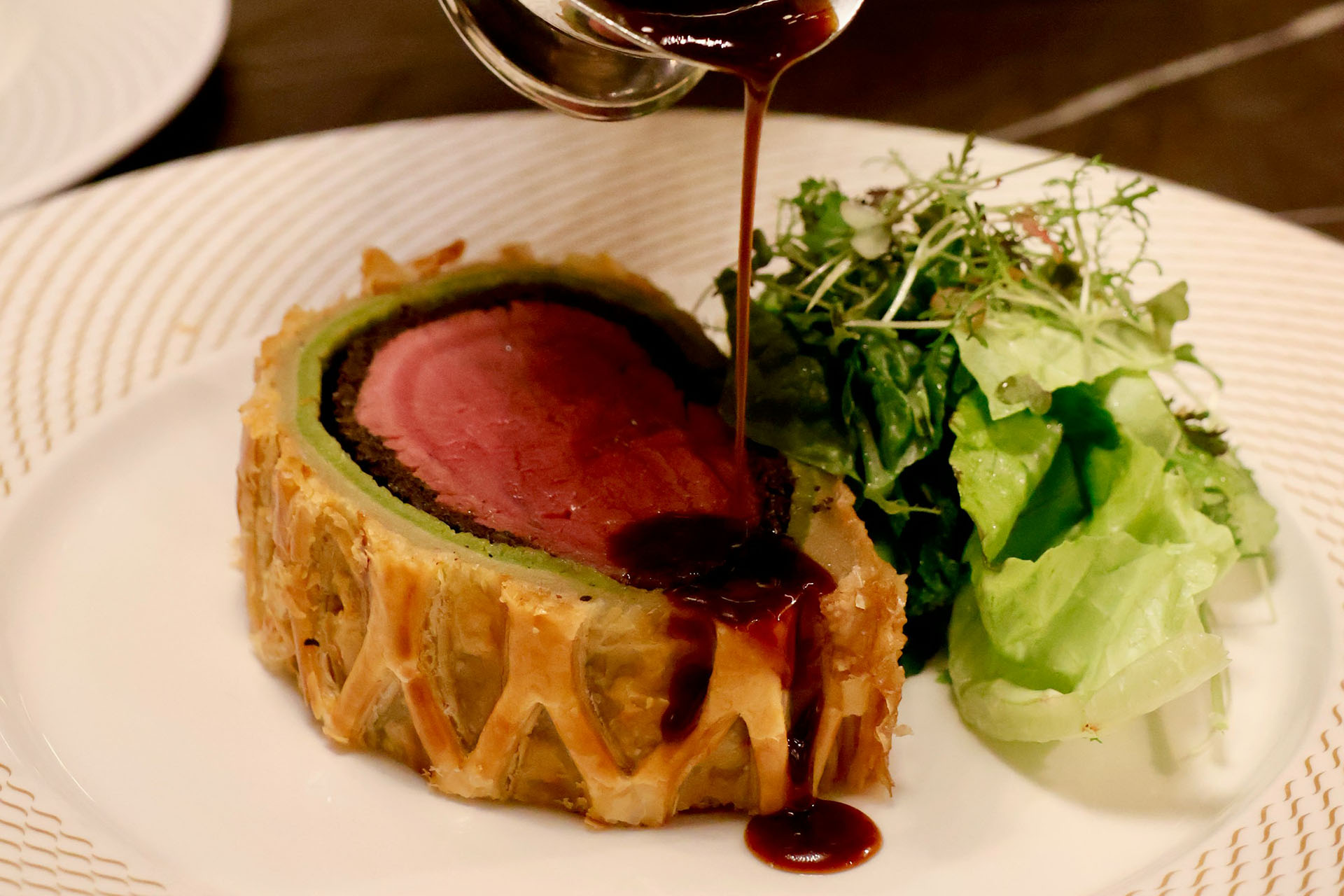
Beef Wellington
If we could sum up luxury on a plate it would have to be a slice of classic Beef Wellington. This esteemed dish is often saved for special occasions, as the premium cut of fillet comes with a price tag. However, when we see this dish on the menu it’s usually ordered without fail.
Classic Beef Wellington is made with prime beef fillet encased in rich duxelles (mushroom pate), and wrapped in buttery, flaky puff pastry. The perfect ‘Wellington’ should be pink in the middle with no soggy pastry bottom. This is one of the hardest recipes to get right as it is so easy to overcook the fillet, or even worse, undercook the dish leaving the pastry looking like a congealed mess. For this reason, Beef Wellington is best ordered at a top restaurant.
The history of the Beef Wellington is said to date back to the 19th century when the dish was made in honour of the Duke of Wellington (Arthur Wellesley) who won the Battle of Waterloo in 1815. Another possibility is that the dish was named as such as the final baked result resembled a wellington boot!
If you’re looking for a superb version while in London, we have chosen a legendary restaurant which is a must if you desire your ‘Wellington’ cooked to perfection. The Savoy Grill located within the iconic Savoy hotel has been serving their exceptional dishes since 1889. The Wellington is regarded as their much sought-after, signature dish. What makes this dish so extraordinary is the quality of ingredients: tender fillet with a perfectly pink centre, a rich layer of duxelles with thin, flaky pastry, served with an accompanying red wine jus. It’s an expensive dish for sure, but well-worth it. We recommend ordering with a side of Pomme purée or even seasoned fries…or both!
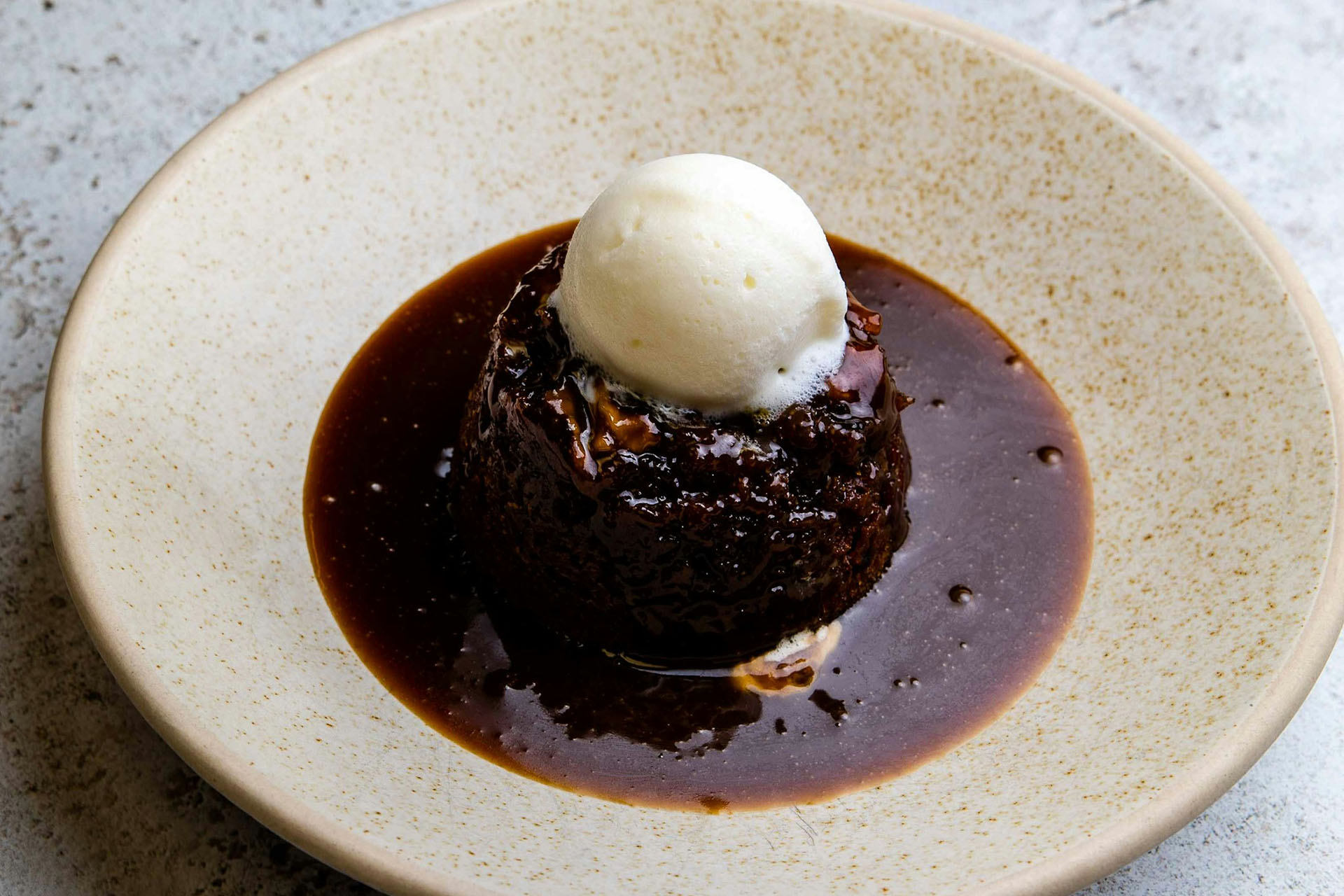
Sticky Toffee Pudding
If there’s one dessert which seems to unify almost all sweet tooths it is the lusciously decadent Sticky Toffee Pudding. This dessert or ‘pudding’ (probably the better term) is an indulgent, carb-rich bowl of toffee sponge cake laden with oozing sticky, toffee sauce. It sounds simple, but getting it just right is so important: the pudding can’t be too sweet and sickly, and the sponge requires plenty of toffee sauce, more than you might think. If the bowl arrives at your table swimming with sauce, consider yourself lucky – it’s exactly how it should be. The sponge pudding is often served with a scoop of vanilla ice-cream, pouring cream or even custard.
The origin of this world-famous dessert is often contested, but it is commonly said to have been created in the picturesque area of the Lake District, specifically at the Sharrow Bay Country House Hotel during the 1970’s. However, it was also said to have been originally made from a charming shop in Cartmel called Cartmel Village Shop (still in operation today) where they have been baking their famous Sticky Toffee Puddings over the past 20 years.
If you’re after a truly decadent slice of Sticky Toffee Pudding while in London, may we point you in the superlative direction of Rules restaurant in Covent Garden. Famously known as London’s oldest restaurant, serving classic British dishes in a refined and traditional setting. The dessert here is perfection, with the ideal amount of oozing, toffee sauce.
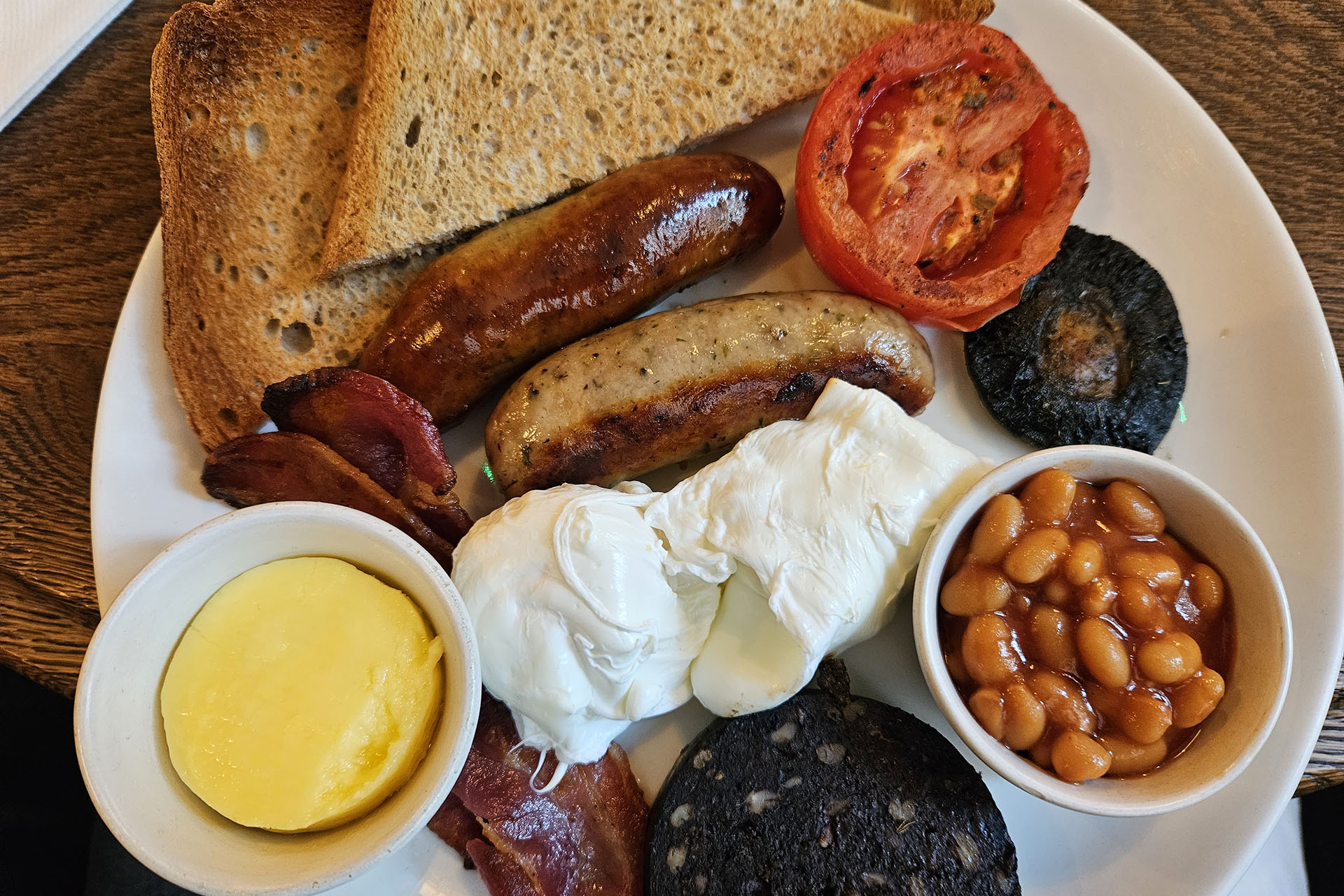
Full English Breakfast
If there’s something the Brits can all agree on is that you can’t beat a proper English Breakfast. This hearty, often over-flowing plate is served from breakfast until brunch, with some venues even serving right through the day. A generous fry-up should consist of bacon, sausage, egg, black pudding, baked beans, mushrooms, hot buttered toast, and sometimes, even fried potatoes. Of course, there are always variations, but what is certain is that the plate shouldn’t have any available space – if there’s any room for manoeuvre you haven’t filled it to its full potential!
This traditional and much-loved breakfast first came about during the Middle Ages, although not as varied and ‘full’ as we are fortunate to enjoy now. Most families would only have two meals a day, with the first meal consisting of bread, cold meat and cheese.
It was during the Victorian era that the fried breakfast really came to prominence, particularly for the middle classes who used the meal as a chance to show off to their friends by having a bountiful feast at the table. It became something of an event meal with eggs and bacon being served, as well as offal and fish dishes.
Its popularity continued to grow, and from the 1950’s onwards has consistently been one of the most popular breakfasts throughout the UK. What we love about this breakfast dish is that there are so many variations depending on where you order: if you’re in Scotland for example, expect to see some Haggis on your plate.
So, if you’re now convinced by the Full English offering may we suggest a visit to Regency Café in London which will surely sate any breakfast cravings. This charming café is something of a London legend, serving their classic, no-frills breakfasts since 1946 – it’s a must-visit.
You May Also Like
London’s Top 3 Must-Try Christmas and Festive Menus
Tis the season of the annual festive menu, and London’s restaurants are brimming with some of...
The Mayfair Chippy Arrives in Knightsbridge
The quintessential fish and chip feast is a meal worth savouring - and not just on ‘fishy’...
Classic Pies and Proper Pints at Fitzrovia’s Iconic Newman Arms
The historic Newman Arms is one of London’s most legendary pubs, newly reopened after an...
